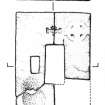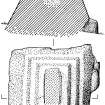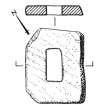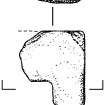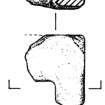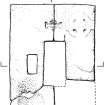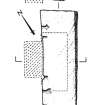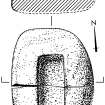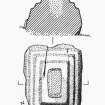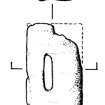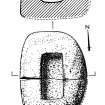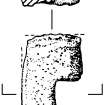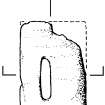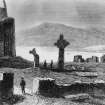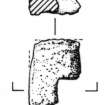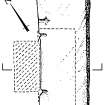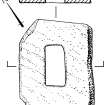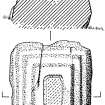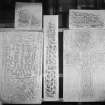Following the launch of trove.scot in February 2025 we are now planning the retiral of some of our webservices. Canmore will be switched off on 24th June 2025. Information about the closure can be found on the HES website: Retiral of HES web services | Historic Environment Scotland
Iona, St Matthew's Cross
Cross (Early Medieval), Cross Base (Early Medieval)
Site Name Iona, St Matthew's Cross
Classification Cross (Early Medieval), Cross Base (Early Medieval)
Canmore ID 21655
Site Number NM22SE 4.06
NGR NM 28646 24502
Datum OSGB36 - NGR
Permalink http://canmore.org.uk/site/21655
- Council Argyll And Bute
- Parish Kilfinichen And Kilvickeon
- Former Region Strathclyde
- Former District Argyll And Bute
- Former County Argyll
NM22SE 4.6 28646 24502.
(NM 2865 2450) St John's Cross (NR)
OS 25" map (1900)
The shaft of a high cross of sandstone sculptured in relief, standing in its stepped base and probably dating from about 800. Although formerly known as St John's Cross, it is now called St Matthew's Cross, neither name being of any great age.
J J Waddell 1941; J Morrison 1953; J R Allen and J Anderson 1903; R Reece, undated
Field Visit (9 June 1972)
As described.
Visited by OS (RD) 9 June 1972
Field Visit (September 1980)
St Matthew’s Cross.
The broken shaft of this cross stands in a stepped granite base some 12m W of the w door of the abbey church and 7·3 m SSW of St John's Cross. A fragment comprising the s arm and part of the head, broken off before 1764, was identified among loose stones at the nearby well during the present survey, and is now displayed at the foot of the cross. The existence of a cross named after St Matthew is first mentioned by Johnson in 1773. Earlier references by Martin and Pococke to 'St Martin's Cross' should probably be associated with St Matthew's (infra), while some 19th-century writers describe it as 'St John's Cross'.
The visible portion of the shaft measures 1·56m in height by 0·54m in width and 0·23m in thickness. About 0·2m of the butt is concealed in the cross-socket, and Graham states that part of it was broken off when the cross fell in the 1840s. Before that accident, the lower part of the head also remained intact, as is shown by Walker in 1764 in a rough sketch which indicates that the total height then surviving above the base was 2.14 m. The portion of the head then intact comprised part of the disc and the N arm, apparently without its ring, as is suggested by Botfield's description of the cross as 'curved at the top so as to resemble the imperfect spandril of an arch'. Graham's drawing shows that even after the fall of the cross the stump of the S ring-segment remained visible, but this is not recorded in Stuart's illustration made after the shaft had been re- erected, and no trace of it is now identifiable. On the basis of this graphic evidence and the rediscovered fragment , the cross can be reconstructed with proportions resembling those of the South or Tower Cross at Kells , the height being at least 2·7m and the span 1.58m. The material used is a coarse grey sandstone or greywacke, possibly derived from Colonsay, which has suffered severe exfoliation, particularly on the w face. The shaft displays several oblique surface-cracks, and it is evident from Walker's sketch, and from the lower edge of the rediscovered fragment , that the latter had broken along a parallel line of weakness.
St Matthew's Cross stands in a base of Ross of Mull granite, resembling that of St Martin's Cross. It measures 1·37m from N to S by 1.15m transversely and rises, with two intermediate steps, to a height of 0.79 m above present ground-level. The socket measures 0.52 m by 0·25m.
It is suggested on p. 19 that St Matthew's Cross probably dates from the 9th or early 10th century.
See RCAHMS 1982 pp.208-211 for a full description.
RCAHMS 1982, visited September 1980.
Reference (2001)
(Iona 84) ST MATTHEW'S CROSS. Until it was removed to the Abbey Museum in 1994 the much-damaged shaft stood in a granite base (no.98) 12m W of the abbey church. A fragment of the head and S arm, broken off before 1764, is preserved beside the base. Drawings by Walker (1764) and Graham (1850) show successive stages of disintegration. The shaft measures 1.56m by 0.54m by 0.23m, but in 1764 it stood to about 2.14m and the span was about 1.58m. The moulded ring was about 1.08m in diameter and the armpits were unpierced but sunken. Both faces have double-moulded margins, which on the W incorporates continuous pellets. The lower shaft of the E face preserves a square panel of diagonal key-ornament and a damaged representation of the temptation of Adam and Eve, who stand below the fruit-laden branches of the tree. The serpent is coiled round its trunk and, as on the Broken Cross at Kells, its tail is knotted round the root which splits to merge into the enclosing bead-moulding. The W face bears paired circles of double-beaded knotwork below traces of figure-sculpture which, if Martin's account referred to this cross, included the Crucifixion.
(Iona 98) St Matthew's Cross stood in a granite base, 1.37m from N to S by 1.15m and rising, with two intermediate steps, to a height of 0.79m. The socket measures 0.52m by 0.25m.
I Fisher 2001.
External Reference (28 October 2011)
Scheduled as element within 'The monument known as St Mary's Abbey, Iona, monastic settlement [comprising] the remains of the large early historic monastic settlement founded by St Columba in AD 563, St Martin's Cross, and parts of medieval buildings associated with the Benedictine Abbey of St Mary founded around AD 1200.'
Information from Historic Scotland, scheduling document dated 28 October 2011.

















































